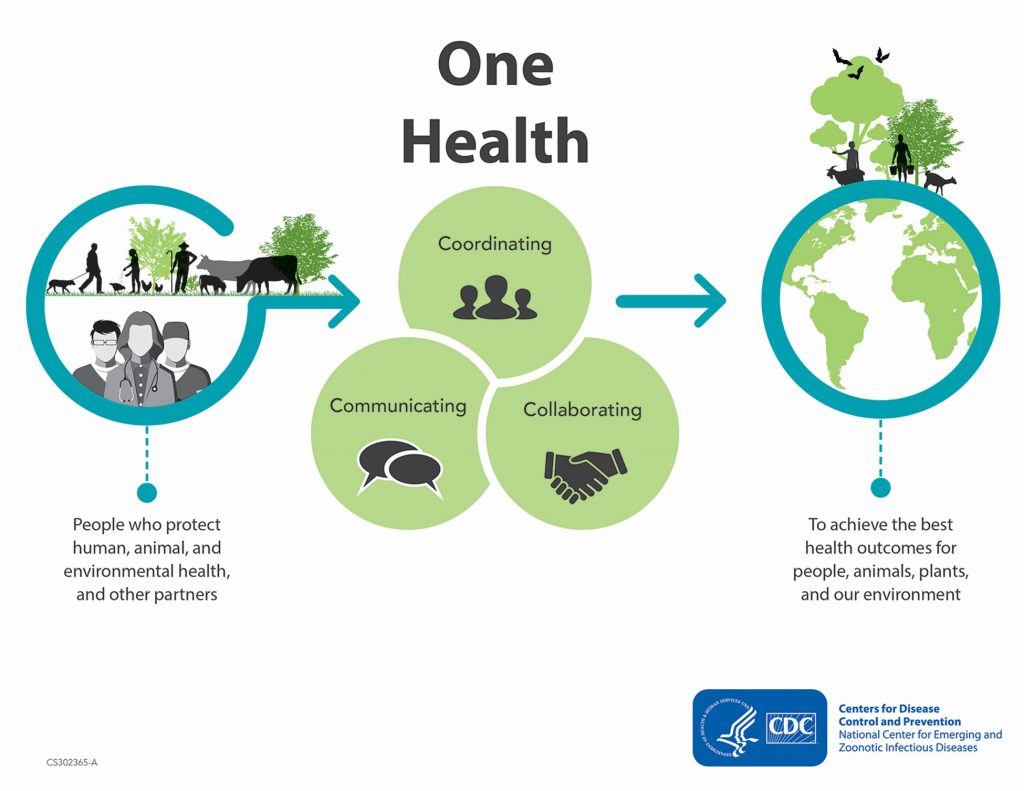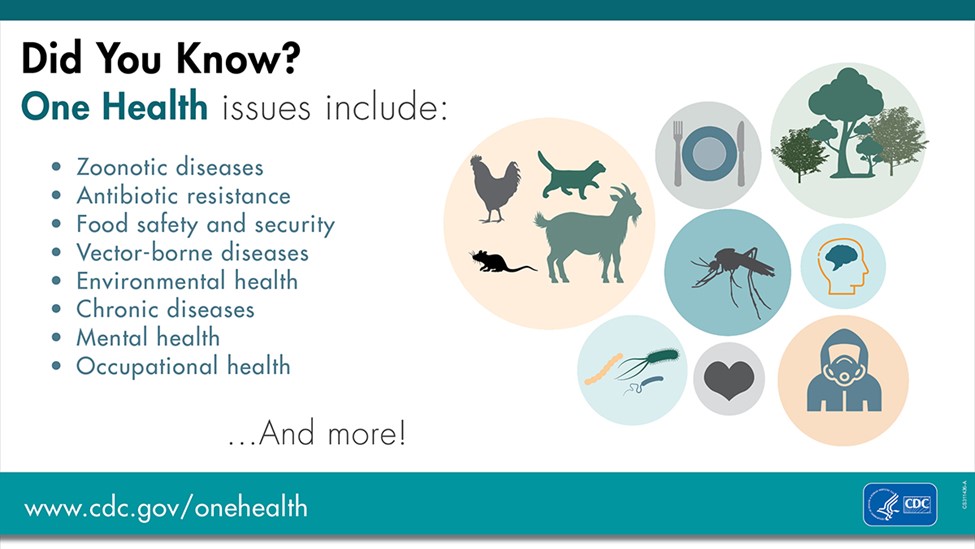One Health means solving problems by thinking about people, animals, and the environment.
One Health is a multi-field approach to solving health problems that works at the intersection of human, animal, and environmental health. The idea behind a One Health approach is that the health of people, animals, and our environment is all connected and that we should consider those connections when making decisions for any one of those topics.

Why do we need One Health?
We (people) are shaping our environments more than ever before, which means a One Health approach is more important than ever. Think about what we are doing via population growth:
- Energy production (Ex. nuclear, coal, wind, solar)
- Resource use (Farming, Fishing, Forests)
- Movement (Ex. travel, trade, migration)
And then think about some of the influences this has on the world around us including climate change, ocean acidification, and habitat loss.
These factors put people in closer proximity to animals, shape our natural environments, and can help a disease or invasive species spread around the world faster than we know it.
What are some examples of One Health?
Ticks spreading Rocky Mountain spotted fever
A One Health approach can be used with almost any health issue, but one of the most common uses is for zoonotic diseases, which are diseases that spread between people & animals, such as flu, rabies, Zika virus, Lyme disease, and COVID-19.
In one CDC example of how One Health works, scientists set out to address a problem with ticks in the southwestern U.S. and Mexico. The brown dog tick carries Rocky Mountain spotted fever, which can affect people and animals, such as dogs. In the example, dogs in the community were carrying infected ticks around the community.
To address the problem, scientists addressed three different components:
- People: provided community education on tick prevention
- Animals: put tick collars on dogs & spayed and neutered dogs to reduce the number of hosts for the ticks (by reducing the feral dog population)
- Environment: sprayed pesticides around the homes to kill ticks
The result was that the number of Rocky Mountain spotted fever cases went down and most of the dogs were tick-free. Read more about the story here.
Anthrax in Malawi
Another One Health success story shared by The International Association of Public Health Institutes (IANPHI) involved an anthrax outbreak in Malawi. At the end of 2018, public health officials with the Public Health Institute of Malawi found increasing numbers of dead hippopotami in a river. They worked with local wildlife/agricultural and water development officials to investigate and found that the hippopotami were dying from the bacterial infection, anthrax. Anthrax can also cause serious skin and lung infections, and even death, in humans. It is spread typically by direct contact. The Public Health Institute of Malawi quickly got to work using a One Health approach:
- People: the local public health, wildlife/agriculture, and water authorities worked together to share updates and information. They sent extra antibiotics to local organizations to prepare for possible human infections. They talked with the community at village and school meetings, sharing information about the investigation and how to prevent human infection.
- Animals & Environment: Surveillance by air looked for animal carcasses to remove and veterinary officials were included in planning and meetings.
In the end, hippo deaths decreased and no anthrax spread to people. Read more about this One Health success in the IANPHI story.

Who can work in One Health?
To use a One Health approach, you need to first invite all relevant groups to the table. Some common examples of experts are listed below, but others who might need to be consulted depending on the issue include policymakers, pet owners, travelers, statisticians, hunters, etc. Experts at all levels can use a One Health approach: government, academia, non-profits, and industry.
| Human | Animal | Environment |
| – Healthcare Professionals (doctors, nurses) – Public Health Professionals (epidemiologists, laboratorians) – Communities and community leaders (rural, Indigenous) | – Veterinarians – Farmers – Agricultural Workers | – Environmental Scientists – Ecologists – Wildlife & Forestry Experts – Land Managers |
One Health can improve the health of people, animals, and the environment. We have to remember that our impact on one area can affect the others too.
What can you do?
The next time you need to address a problem or situation in your community think about all the groups who will be affected including the humans, animals, and environment. This will make your solution more equitable and also give it greater chance for success.
Tell your friends and family about One Health! The One Health approach is catching on, but many people still don’t know about it. The more people that know about One Health, the more support there will be for bringing different groups together to work on a problem from a different perspective.
Science for Georgia Focus
Throughout 2021 Science for Georgia will focus on the basics of life: water, food, and shelter. The COVID-19 pandemic brought more public awareness than ever to the long-standing systemic and social disparities that put certain groups, particularly many racial and ethnic minorities, at an increased risk of death or illness. Focusing on evidence-based solutions for access to these basic resources requires accounting for One Health.
